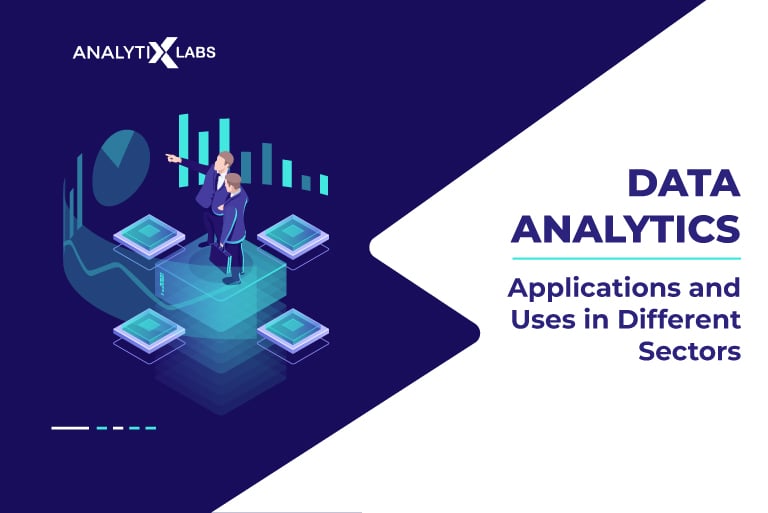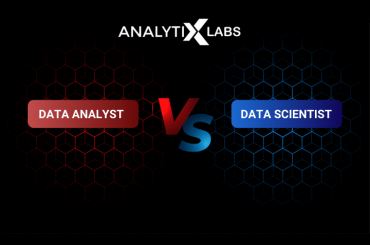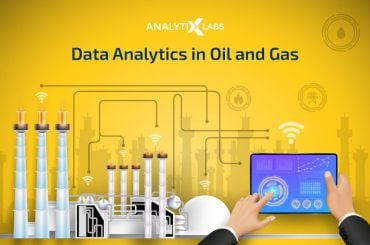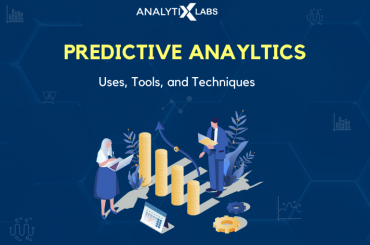Data is being produced by almost all companies throughout the world today. If used correctly, this data can help the executive to make informed decisions, create effective strategies, and improve the efficiency of the company’s operations. According to the Global State of Enterprise Analytics report, data analytics applications led to faster and better business decisions in various fields.
While informative and effective decision-making is one significant advantage, there are many others, such as
- Better efficiency and productivity
- Higher financial performance
- Innovation of new products
- Development of new streams of revenue
- Improvement in customer acquisition
- Reduction in customer churn
Given all these advantages, it’s no surprise that various domains have started incorporating data analytics in their day-to-day operations. In this article, numerous applications of analytics are discussed. Even though almost all companies can take advantage of this discipline, the use of data analytics can differ from business to business.

Let’s start with the industry greatly benefiting from the data analytics application – Transportation.
Transportation
The transportation industry is highly dynamic, as the movement of goods and people can depend on multiple factors. There are many applications of data analytics in the field of transportation that have immensely benefitted this industry. Some of the common uses of data analytics include-
-
Route Planning
To ensure the timely transportation of goods, one must consider multiple factors such as traffic, weather, day of the week, holidays, nature of the goods being transported, etc. This requires the transport companies to develop route plans to consider all the plausible events and provide the time estimate accordingly.
Similarly, for cab services that, rather than goods, move humans from one place to another, their profit margin highly depends upon the fuel they conserve. For such companies, efficient route planning is crucial. Planning such routes can be done using data analytics, where the best route is identified, given all the factors discussed above.
-
Capacity Planning
Transportation companies must also identify the ideal vehicle given the number of goods or humans they carry. Applying data analytics to solve such problems is considered a good idea.
-
Transparency
Today, transportation companies heavily rely on satellite navigation systems like GPS. The data feed of where the vehicle is can be used for increasing transparency. This way, cab services can know the location of all the operators, and the customers can track where the cab is, and they can share their live location with others.
-
Demand Prediction
Cab services and other transportation companies can ensure that they do not lose out on customers due to the unavailability of vehicles. This is where an actual application of data analytics comes in handy – demand prediction. Using historical data, companies can forecast demand and ensure they can effectively serve their customers.
-
Dynamic Pricing
As you would have noticed, the price of a cab service for the same route can differ at different times of the day and depend on the day itself. Here, the application of models in data analytics is leveraged as pricing models are created that predict the amount customers would be willing to pay given the day and time of day.
Logistics
One end of logistics operations is the transportation of the goods discussed above, and the other is the storage of the goods. Here, among the many applications of data analytics, is enabling smart warehousing.
-
Smart Warehouses
In warehouses, the product is stored until they are moved to its next destination. It’s an essential aspect of supply chain logistics besides transportation. Now, the issue is that the goods that are to be stored can differ in nature. While some can be perishable, like fruits and pharmaceuticals, others may be non-perishable but hazardous.
Also, the time that the goods are to be stored can differ. While some goods might be required to move much later, others might have to be moved quickly. The data analytics applications can enable the warehouse to store perishable and hazardous goods so that the correct packaging and temperature are ensured and the goods are not harmed.
Depending on the requirement, the goods that are not to be moved immediately can be stored at the back (less accessible part of the warehouse), while others may be required to move shortly and be placed such that moving them is less time-consuming.
-
Operation Efficiency
If the goods are correctly placed in a warehouse, it can lead to islands of unutilized space. This, in turn, can reduce the revenue of a logistics/warehousing company. Data analysis applications include using data such that the waste is minimized, thereby helping the company reduce cost, increase their value, and increase overall efficiency and transparency in the operations.
-
Customer Satisfaction
If customer retention is increased by 5%, the profit, in turn, increases by 25% (as per a study by Brain & Company). Therefore, increasing customer satisfaction is an important goal for any company. Customer Satisfaction for a logistics company means that their goods are picked, stored, and delivered promptly without damage.
If they have any change of plans, queries, or complaints, they should be addressed promptly and efficiently.
Lastly, suppose the whole process is transparent, and they know at every step where their product is and are communicated regularly regarding the timelines. In that case, this dramatically helps customer satisfaction. The various applications of data analysis are to create mechanisms and methodologies that provide up-to-date data to the customer, and logistic companies take advantage of this.
-
Risk Evaluation
The world during and after the COVID pandemic has seen how inflation has wrecked economies worldwide. Of the many reasons, supply chain disruption is one the most significant contributing factor. Logistics companies, therefore, need to use data analytics such that they can reduce the bottlenecks and streamline the supply chain.
The Applications of data analytics include much more than just transportation and logistics, and the most prominent domain that heavily relies on data analytics is web search engines.
Web Search
Firms like Google and Microsoft, which developed web search engines, were among the initial adopters of data analytics. The data from millions of websites is matched based on the user-provided keywords, and the most appropriate one is provided to the user.
The applications of data analytics thus include gathering large amounts of data submitted by different websites, grouping them as per user keywords, ranking them based on relevancy, filtering inappropriate web pages, translating the pages if required, etc.
At an advanced level, data analytics can be used to look specifically for a particular keyword, reverse search images, etc. If not for various analytics applications, Google would not have been able to process over 20 petabytes of data daily.
Customer Care/After Sales
Data-driven companies are considered 23 times more likely to acquire customers, so most companies emphasize using data analytics to take care of their customers and handle after-sales services.
Here, the application of models in data analysis gets highlighted as a business can use predictive and forecasting models to foresee and handle many issues. Common applications include-
-
Understand Upcoming Demand
By analyzing customer behavior, a business can understand upcoming trends. That way, they can develop new products or make sure that they have enough of those products that will be in demand.
-
Personalized Experience
Customer satisfaction substantially increases if they feel that the companies care for them. By understanding a customer’s situation, the business can help them by providing personalized offers, services, products, etc. Today, consumers look beyond just buying a product and want a good experience while using it.
-
Singular View of Customer
To understand your customers and their needs, you must ensure that every company department has a holistic idea of the customer base. Typically, a customer deals with a company through multiple points of contact. Through data analytics, all this data can be combined to provide the various departments with a 360-degree view of the customer.
This way, the services provided to the customer can become more effective as the concerned department will not only have the information that is related to them but also of others (this helps them to understand the customer’s experience better)
-
Identify Customer Pain Points
Data can help you understand where the complaints are bothering your customers. For example, if many complaints are being directed after the customers have spent a substantial amount with chatbots or self-service portals, this would indicate that the customers are unhappy with the current service state.
This is just one example. By adequately analyzing data, the business can understand and rectify the root causes of customer problems.
-
Customer Review and Suggestion analysis
According to Microsoft, 37% of Americans think companies do not consider their feedback. While some of the feedback might be redundant, a vast majority is the customer base speaking with the company. By analyzing customer feedback and suggestions, a data analyst can understand the common issue that is being faced by the customers and what they expect from the company.
-
Reward Customers
Customer retention is key to any business. While there are many ways to retain a customer, having a loyalty program is one of the most common ways. Through data analytics, high-value customers can be identified and encouraged to stay with the company by offering additional products, services, redemption points, etc.
-
Capture Customer Metrics
When providing after-sales services or addressing customers, having a lot of information about the customer is always a good idea. Incorporating data analytics can nudge companies to capture in-depth information about a customer’s experience. Standard metrics that can help data analysts include-
- Average response time in addressing and solving customer complaints
- First contact resolution
- Ticket Volume
- Customer Satisfaction Score
- Net Promoter Score
- Customer Effort Score
-
Follow up on After Sales Services
Data analytics can help understand the data once the customer problem has been addressed and solved. This way, the weak points in the customer redressal process can be identified and made better.
Also read: What is Customer Analytics – Use Cases, Tools, and Best Practices
Business Decision Making
Data analytics aims to allow the business to run effectively, reduce costs, and maximize profit. The use of data analysis achieves all this as it helps the business decision-making in the following manner-
-
Accountability
Data Analytics helps the leadership understand what work is done by the individuals in the company. As the work is properly assigned and tracked, it helps in increasing transparency and accountability, causing better performance.
-
Perpetual Improvement
When a decision is taken using data and the outcome is also captured, it nudges the business to know if their decision was wrong or right. If their decision is wrong, it makes them introspect and identify the issues, whereas if the decision turns out to be correct, then the executives can repeat it. All of this helps to improve the company’s decision-making capability.
-
Consistency
The data-backed decision allows for consistency in decision-making. This happens because the scope of making decisions using intuition or gut feeling is reduced. Therefore, data analytics helps to standardize the decision-making process, helping companies have consistent management whose decisions don’t change drastically if some C-level executives are replaced.
-
Cost Reduction
Data analytics helps to automate routine procedures like report generation etc. This helps reduce the workload and frees up human resources that can be deployed for achieving more significant objectives. Therefore, using data analytics not only increases productivity but also reduces costs.
Also read: Evolution of Business Analytics And Its Future
Streamlining Operations
Companies today perform many operations that, if not streamlined, can create mass confusion in the company, leading to revenue loss. Data Analytics help streamline a company’s operations in the following manner-
-
Fresh Business Insights
When operations are being performed at a large scale, it becomes difficult to innovate and develop new business insights. By analyzing the abundant data available to the companies, they can get new insights into their functioning.
-
Real-Time Analysis
Business analytics can help companies analyze their surroundings in real-time by using an analytics engine that can take in data from multiple sources and provide insights immediately to the stakeholders. This greatly helps in increasing the operational efficiency of a business.
Security Enhancement
Security is a major concern for countries, companies, and individuals. It is a controversial field where data analytics has created a revolution. The application can range from simple intrusion detection by homeowners to more problematic mass surveillance by governments. A few typical applications of data analytics in the world of security are the following-
-
Avoiding Attacks
Through various machine learning algorithms, data analytics can help prevent threats before they appear. By analyzing the security systems and their historical data, systems can be developed that warn of the potential methods and places of attack before they occur.
-
Large Scale Monitoring
In companies where thousands of emails are received and sent daily, the data can be compromised by the mistake of any employee. Large-scale monitoring is required where many systems and their users are minored to ward off cyber threats. Automation is also encouraged to minimize data breaches and speed up the recovery of any lost data.
-
Real-Time Intrusion Detection
Data Analytics is responsible for creating Intrusion Detection Systems (IDS) that can detect real-time malicious activities in systems. These systems can help monitor the overall health of companies’ systems.
-
Risk Management Reporting
Reporting is an essential aspect of data analytics. In cybersecurity, reporting is also critical, as reports of authentication failures, incidents, and activities during non-business hours are to be captured and reported to the concerned people.
-
SIEM Platforms
Data Analytics helps create Security Information and Event Management platforms where the data is analyzed using pre-defined business rules and policies, and many non-compliant activities are flagged.
-
Fraud Detection
Fraud detection is commonly used in financial companies and is discussed in the application of data analytics in the financial domain section of this article.
-
Anti-Malware Sandboxes
To deal with malware, sandboxes are created. An environment is constructed so that the behavior of malicious files can be analyzed, allowing the concerned team to explore their nature and how their threat can be mitigated.
-
Regulatory Compliance
Data from unsecured sources or places that breach or violate data privacy laws can be dangerous for companies. Data analytics can flag the import and use of such data, saving companies millions of dollars in fines.
-
Forensic Capabilities
Security analytics tools function by using extensive data analytics. Such tools help companies know about the sources of a threat, how it breached the system, and the assets that got compromised, along with the timelines of the events. These tools can help the organization make its infrastructure more robust.
Retail industry
Another major industry that is heavily involved in data analytics is retail. As discussed above, customer satisfaction and making an effective business decision are something the retail industry takes very seriously, and data analytics help in these areas. There are, however, certain specific applications that are unique or particularly important to retail companies.
-
Targeted Communication with Customers
The new products being sold by retail companies need to be communicated to customers interested in buying them. Data analytics helps in customer segmentation to enable effective communication.
-
Predict demand and Manage Inventory
Retail companies sell numerous products whose prices fluctuate depending on demand and other social, political, geopolitical, and economic situations. To maximize profits, data analytics is used to stock those products whose prices are predicted to go up.
-
Price Optimization
As discussed earlier, price optimization helps retail companies not sell their products at a loss or overprice their products, leading to a reduction in revenue. Various statistical models can help retail companies, based on the season, market availability of products, etc., to appropriately price their products.
-
Opportunities with high ROI
By using data analytics and analyzing the market, retail companies can identify those products that can provide high returns.
-
New Retail Locations
The success of retail stores depends to a great extent on their location. Suppose a good retail store is in an area where the population is not interested in the product they have to offer. It’s a massive loss for the company.
Data analysts can analyze the area’s demographic and current market scenario, and based on their findings, the executives can have an idea of the rough sales of that store. The decision-makers then can give the go-ahead if the approximate revenue justifies building a store in that location.
-
Market Basket Analysis
Market basket analyses are among the traditional tools data analysts use in the retail sector. There, customers’ purchases are analyzed to identify their likes and dislikes and the connection between their products.
-
Customer Journey Analytics
A customer’s journey searching your store to make the eventual purchases is long, full of twists and turns. Companies try to understand this journey to identify ways to improve their outreach and increase their customer base.
AnalytixLabs offers tailor-made courses on machine learning in data science. You can opt for the Python Machine Learning Course You can also enroll in our Data Visualization and Analytics course and our exclusive PG in Data Analytics course at your convenience or book a demo with us.
Healthcare
The most critical and applauded application of data analytics is in the field of healthcare. Today, data analytics has revolutionized this sector, allowing care to become more efficient and democratized. Let’s discuss a few critical applications of data analytics in healthcare.
-
Improve Medical Research
Various data analytics techniques are being applied today to improve medical research. The clinical data is sourced and analyzed from multiple sources to improve research capability. Common data types include Electronic Health Records (EHR), electronic medical records, personal health records, public health records, etc.
When the data about an individual is combined during all these records, it becomes possible to perform research considering multiple aspects.
-
Improve Health Outcomes
The fundamental goal of data analytics in healthcare is to improve healthcare outcomes. Today’s healthcare environment is complex, and data analytics makes it possible to reduce the trauma associated with complicated treatment.
This is done by analyzing patient data, understanding their background, and planning the procedure accordingly. Efficient analysis of clinical data makes it possible for healthcare providers to lower readmission rates, errors, complications, etc.
-
Better Operatorial Insights
In countries like India, healthcare resources are limited, and their efficient use is crucial. Data Analytics can help improve healthcare quality by making them operationally efficient. This done by-
- Reducing cost by limiting clinical practice variations, preventing care-related injuries, and limiting procedure irregularities.
- Using data-driven technologies such that the cost of healthcare can be reduced. The use of robots and consulting by doctors through IOT for those patients who are in remote places is an example of it.
- Data analytics can better manage the capacity of beds in hospitals so that operational availability becomes higher.
-
Improved Staff Quality
The prominent use of data analytics is in HR, and human resources is crucial in healthcare as a wrong decision can cause loss of life. Data analytics can be used to shortlist suitable candidates.
-
Anomaly Detection in Scans
Today, algorithms are being created to read scans better than humans and identify anomalies. The algorithms can train millions of historical data and identify differences in scans faster than humans. All of this allows for the early detection of diseases.
-
Predicting Outbreaks
Continuing the previous idea, by analyzing historical data, data analysts can predict major disease outbreaks and model their impact on the world. The prevalence of data analytics in the world of healthcare warned of a pandemic like COVID much before it happened and eventually modeled its effect upon its actual outbreak, allowing the administration to take preventive actions.
-
Insurance
Medical insurance companies heavily rely on data analytics as it can help them identify risky applicants, set the premium accordingly, and even advise them on insurance plans based on their medical history.
Banking sector
The early adopters of data analytics were the banking sector. This was mainly because the banking industry captured the data in the most structured manner and was the first to deploy strict data hygiene. The early adoption of data analytics allowed them to create complex financial products by analyzing vast amounts of data. A common use of data analytics in banking includes-
-
Customer Segmentation
Customers can be segmented based on their life stage, and the products can be provided accordingly. For example, individuals in urban areas between 20 to 30 can be provided with vehicle loans, whereas those above 60 or 70 can be targeted for retirement plans.
-
Transaction Anomaly Detection
You sometimes would have gotten an alert message or email from your bank if you suddenly made a high-value purchase or purchased some product at a location you visited for the first time.
Sometimes, the credit card is blocked as the bank considers the transaction anomalous. This is an example of the real-time monitoring of the transaction by the bank to identify any fraud and protect their customers by taking some action.
-
Risk Modeling
Retail banks’ primary source of income is generated through the interest paid by customers on loans. If loans are not provided to a potential applicant, revenue is lost. At the same time, if a risky applicant is provided with a loan that defaults later is also a loss-making proposition.
Therefore, data analytics is used to create a model that does the risk profiling of their applicants and the customer base in general. This way, the risk taken by the bank is minimized.
On the other hand, investment banks also perform risk modeling, evaluating the risk and return of an investment opportunity and making decisions accordingly. If such banks do not diversify their investment properly and play it too safe or risky, they can lose out to their competition.
FAQs
- What are the uses of data analysis?
Data analytics has many uses in finance, retail, healthcare, transportation, logistics, etc. By and large, data analytics helps make processes efficient and maximize delivery.
- Where is data analytics used in real life?
When you book a cab and a route is identified to reach your destination, or when products are suggested to you when buying products online, these are all products of data analytics aiding you in real life.
- How can data analytics save people’s lives?
Data analytics is heavily used in healthcare that help in the early detection of diseases that reduce patient mortality rates.
I hope you gained a decent knowledge about the application of data analytics. If you wish to know more about this field, write to us at Analytixlabs.








